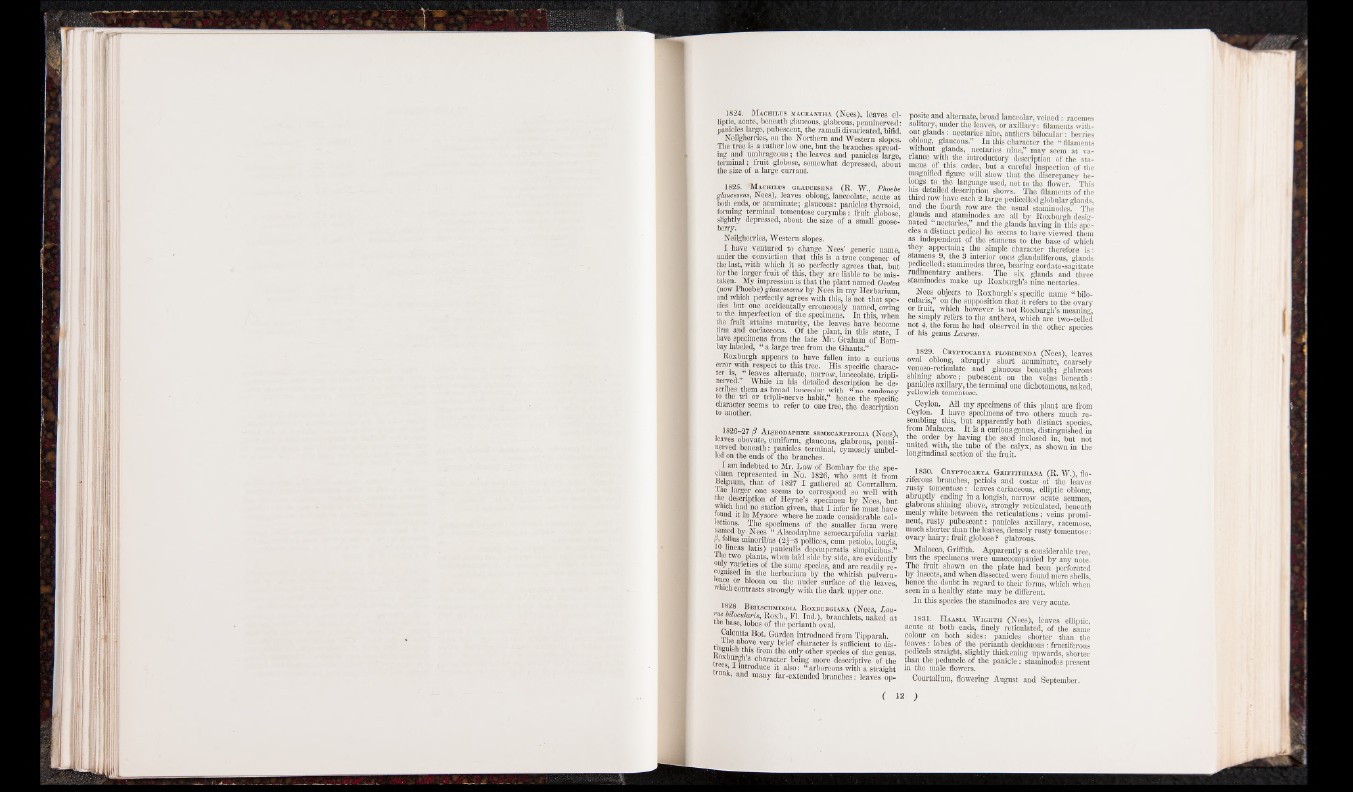
1824. Machu,tjs macrantha (Nees), leaves elliptic,
acute, beneath glaucous, glabrous, penninerved:
panicles large, pubescent, the ramuli divaricated, bifid.
Neilgherries, on the Northern and Western slopes.
The tree is a rather low one, but the branches spreading
and umbrageous; the leaves and panicles large,
terminal; fruit globose, somewhat depressed, about
the size of a large currant.
1825. "Machilus glaucesens (R. W., Phoebe
glaucesens, Nees), leaves oblong, lanceolate, acute at
both ends, or acuminate; glaucous: panicles thyrsoid,
forming terminal tomentose corymbs: fruit globose,
slightly depressed, about the size of a small gooseberry.
Neilgherries, Western slopes.
I have ventured to change Nees’ generic name,
under the conviction that this is a true congener of
the last, with which it so perfectly agrees that, but
for the larger fruit of this, they are liable to be mistaken.
My impression is that the plant named Ocotea
(now Phoebe) glaucescens by Nees in my Herbarium,
and which perfectly agrees with this, is not that species
but one accidentally erroneously named, owing
to the imperfection of the specimens. In this, when
the fruit attains maturity, the leaves have become
firm and coriaceous. Of the plant, in this state, I
have specimens from the late Mr. Graham of Bombay
labeled, “ a large tree from the Ghauts.”
Roxburgh appears to have fallen into a curious
error with respect to this tree. His specific character
is, “ leaves alternate, narrow, lanceolate, tripli-
nerved.” While in his detailed description he describes
them as broad lanceolar with “ no tendency
to the tri or tripli-nerve habit,” hence the specific
character seems to refer to one tree, the description
to another.
reavca uuuvaie, cumrorm, glaucous, glabrous, penninerved
beneath: panicles terminal, cymosely umbel-
led on the ends of the branches.
I am indebted, to Mi’. Law of Bombay for the specimen
represented in No. 1826, who sent it from
Belgaum, that of 1827 I gathered at Courtallum.
-the larger one seems to correspond so well with
u- £escr*Pti°n °f Heyne’s specimen by Nees, but
which had no station given, that I infer he must have
round it in Mysore where he made considerable collections.
The specimens of the smaller form were
named by Nees “ Alseodaphne semecarpifolia variat
P, tohus minoribiis (2f-3 pollices, cum petiolo, longis,
10 lmeas latis) paniculis depauperatis simplicibus.”
-the two plants, when laid side by side, are evidently
only varieties of the same species, and are readily recognised
in the herbarium by the whitish pulveru-
ience °r bloom on the under surface of the leaves,
which contrasts strongly with the dark upper one.
1828 B eilschmiedia Roxburgiana (Nees, Lau-
rus bilocidaris, Roxb., FI. Ind.), branchlets, naked at
the base, lobes of the perianth oval.
Calcutta Bot. Garden introduced from Tipparah.
t- 1 . aoove very brief character is sufficient to dis-
guish this from the only other species of the genus.
Roxburgh s character being more descriptive of the
t.-n i A m*r°duce it also: | arboreous with a straight
- > an(* many far-extended branches: leaves opposite
and alternate, broad lanceolar, veined: racemes
solitary, under the leaves, or axillary: filaments without
glands: nectaries nine, anthers bilocular: berries
oblong, glaucous.” In this character the “ filaments
without glands, nectaries nine,” may seem at variance
with the introductory description of the sta-
mens of this order, but a careful inspection of the
magnified figure will show that the discrepancy belongs
to the language used, not to the flower. This
ms detailed description shows. The filaments of the
third row have each 2 large pedicelled globular glands,
and the fourth row are the usual staminodes. The
glands and staminodes are all by Roxburgh designated
“ nectaries,” and the glands having in this spe-
cies a distinct pedicel he seems to have viewed them
as independent of the stamens to the base of which
they appertain; the simple character therefore is:
stamens 9, the 3 interior ones glanduliferous, glands
pedicelled; staminodes three, bearing cordato-sagittate
rudimentary anthers. The six glands and three
, staminodes make up Roxburgh’s nine nectaries.
Nees objects to Roxburgh’s specific name “ bilo-
cularis,” on the supposition that it refers to the ovary
or fruit, which however is not Roxburgh’s Meaning,
he simply refers to the anthers, which are two-celled
not 4, the form he had observed in the other species
of his genus Laurus.
1829. Cryptocarta fboribonda (Nees), leaves
oval oblong, abruptly short acuminate, coarsely
venoso-reticulate and glaucous beneath; glabrous
shining above; pubescent on the veins beneath:
panicles axillary, the terminal one dichotomous, naked,
yellowish tomentose.
Ceylon. All my specimens of this plant are from
Ceylon. I have specimens of two others much resembling
this, but _ apparently both distinct species,
from Malacca. I t is a curious genus, distinguished in
the order by having the seed inclosed in, but not
united with, the tube of the calyx, as shown in the
longitudinal section of the fruit.
■; 1830. Cryptocarta Greffithiana (R. W .), flo-
riferous branches, petiols and cost» of th e leaves
ru sty tomentose: leaves coriaceous, elliptic oblong,
ab ru p tly ending in a longish, n arrow acute acumen,
glabrous shining above, strongly reticulated, beneath
mealy white between the reticulations; veins prominent,
ru sty p u b escen t: panicles axillary, racemose,
much shorter th an the leaves, densely ru sty tomentose:
ovary h airy: fru it globose ? glabrous.
Malacca, Griffith. Apparently a considerable tree,
but the specimens were unaccompanied by any note.
The fruit shown on the plate had been perforated
by insects, and when dissected were found mere shells,
hence the doubt in regard to their forms, which when
seen in a healthy state may be different.
In this species the staminodes are very acute.
1831. Haasia Wightu (Nees), leaves elliptic,
acute at both ends, finely reticulated, of the same
colour on both sides: panicles shorter than the
leaves: lobes of the perianth deciduous: fructiferous
pedicels straight, slightly thickening upwards, shorter
than the peduncle of the panicle: staminodes present
in the male flowers.
Courtallum, flowering August and September.